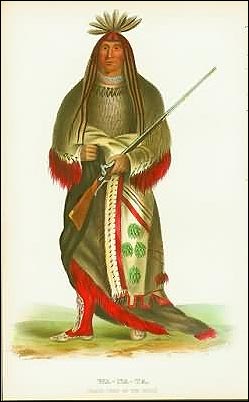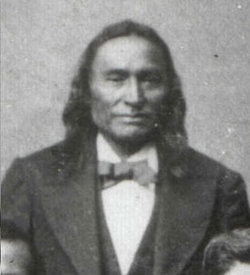Wanata facts for kids
Wa-na-ta (whose name in the Dakota language, Wánataŋ, means One who charges or Charger) was an important chief of the Yanktonai tribe. He was also known as Wanata and Wanataan I. Chief Wa-na-ta was born around 1795. His tribe, the Yanktonai, lived near the St. Peter River, which is now called the Minnesota River in Minnesota. The Yanktonai people were a large group, with about 5,000 to 6,000 members and 1,300 warriors. Wanata was a very strong leader, shown by his ability to guide his warriors into battle.
Wa-na-ta was born in what is now Brown County, South Dakota. When he was 18, he was already experienced in warfare. He fought alongside his father, Wakinyanduta (Red Thunder), who was a leader of the Sisseton Dakota. They joined the British side against the Americans in the War of 1812.
Contents
Wa-na-ta's Role in the War of 1812
Wa-na-ta fought in the siege of Fort Meigs in 1813. He was convinced by British Colonel Robert Dickson to join a battle at Fort Sandusky. During this fight, Wa-na-ta bravely charged at Fort Sandusky and was wounded. This brave act earned him the nickname "Charger."
After the war, the British rewarded Wa-na-ta for his loyalty. They gave him a special captain's rank. He even traveled to England. Wa-na-ta remained friendly with the British until 1820. At that time, an attempt to attack Fort Snelling failed, which made him change his mind. After this, he fully supported American interests. He even helped with trade along the Missouri River.
Treaties and Agreements
As a respected chief of the Dakota people, Wa-na-ta signed a trade treaty with the Americans on July 25, 1825. A short time later, on August 17, 1825, he signed the first Treaty of Prairie du Chien. This treaty helped set the borders for the Sioux territory.
Wa-na-ta died in 1848. He was killed by some of his own tribesmen who were unhappy with his leadership. He passed away near the mouth of the Warreconne River, which is now called Beaver Creek in Emmons County, North Dakota.
Honoring Chief Wa-na-ta
Chief Wa-na-ta has been honored in several ways.
Ships Named After Wa-na-ta
Two ships in the United States Navy have been named after him: USS Wahneta and USS Waneta.
Buildings Named After Wa-na-ta
In 1959, Waneta Hall, a student residence hall at South Dakota State University, was named in his honor. This continued a tradition of naming buildings with words from the Lakota language. Other residence halls on campus, Wenona Hall (meaning first-born daughter) and Wecota Hall (meaning second-born daughter), were named earlier. Wenona and Wecota Halls are now office buildings and are listed on the National Register of Historic Places listings in Brookings County, South Dakota. Waneta Hall is still used by students today.
Chief Wanataan II
Wa-na-ta's son was named Wanata II or Waanatan II (1828-1897). Both father and son are mentioned in many history books about Minnesota and the two Dakota States. Waanatan II was born in 1828 on the Elm River in what is now north of Aberdeen, South Dakota.
Leadership After His Father's Death
When his father was killed in 1848, the Pabaksa (Cut Head) band of the Yanktonai split into three groups, each led by one of Wa-na-ta's sons. Waanatan II moved to Lake Traverse and joined his mother's people, the Sisitunwan Dakota.
During the Dakota War of 1862, Waanatan II did not allow another leader, Little Crow, to cross his lands to escape American troops. Waanatan II and his band faced many difficulties during this war. About five years later, he surrendered his group and lived on the Spirit Lake Reservation in north-central North Dakota.
Friendship with Major Israel McCreight
In 1885, Chief Wanata (Waanatan II) became friends with Major Israel McCreight. McCreight was impressed by the chief's dignity. One day, the chief showed McCreight a very special document. It was a treaty with government officials, and his own name was written on it as the head chief. He carefully put it away, then sat down to smoke his pipe.
Wa-na-ta's smoking pipe was his most treasured item. An English ranch owner offered a lot of money for it, but the chief refused. However, when McCreight told him he was leaving for a trip, Wa-na-ta immediately gave McCreight his pipe and pouch as a gift. McCreight always remembered the chief's kindness.
Chief Wanataan II died in 1897 and is buried in the St. Michael Cemetery in St. Michael, ND.
See also
In Spanish: Wa-na-ta para niños



